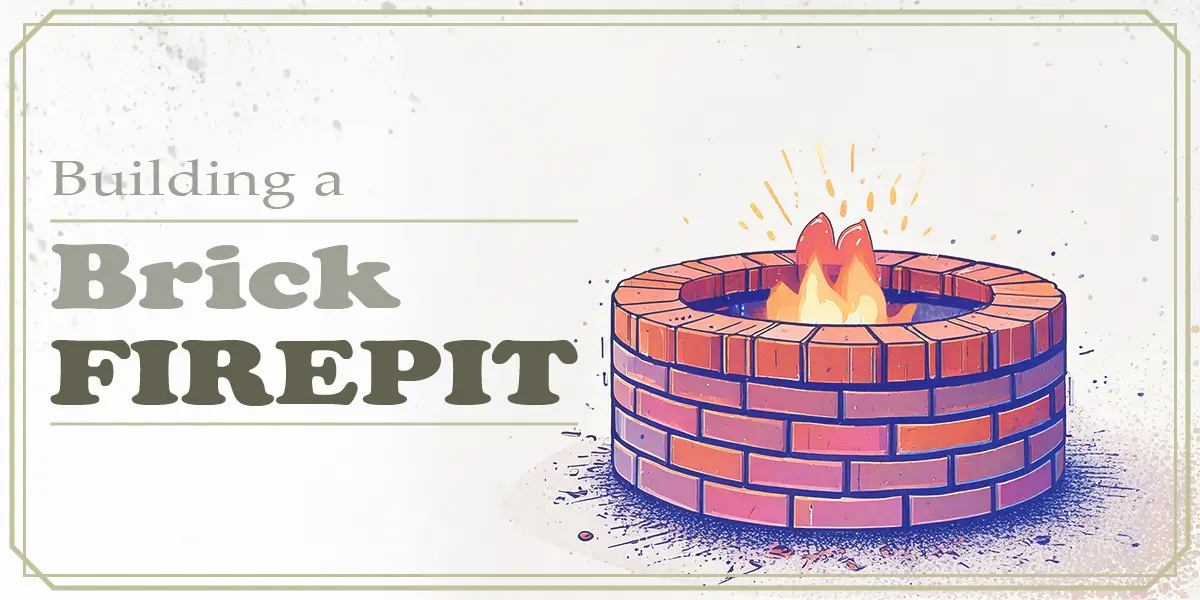Prehistoric humans gathered around fires to keep themselves warm, ward off predatory animals, and cook their food.
Fast-forward to today. Little has changed, except that the predators are mostly gone from urban landscapes.
People still gather around fires, but now it’s more for socializing and relaxation than survival.
Thus, a fire pit is a coveted feature in an urban backyard, a warm and inviting place for parties, family reunions, and other social events.
Don’t have a fire pit or the cash for professional installation? No worries — building one DIY is easier than you might think.
Benefits of Building Your Own Fire Pit
- Pre-made fire pits can cost hundreds of dollars, while a DIY option is budget-friendly. Plus, you can customize the size and look based on your budget.
- Brick fire pits are durable and easy to clean. Remove ashes regularly and cover the pit during heavy rain.
- There’s something about sitting around a fire that fosters conversations and creates lasting memories. A fire pit is the ultimate backyard upgrade.
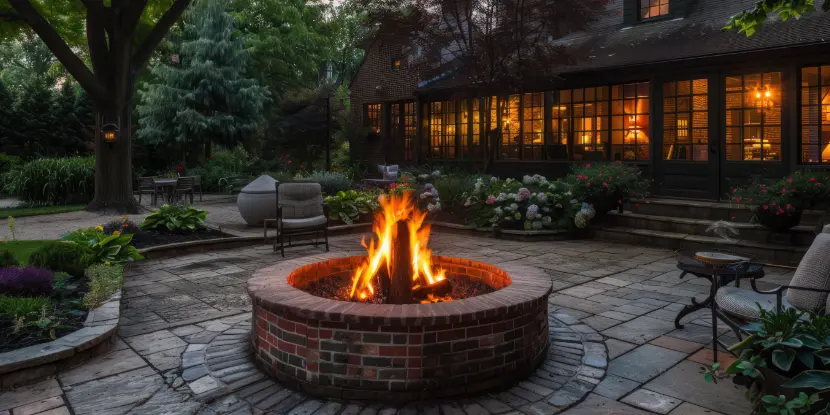
A brick fire pit creates an inviting atmosphere at night.
Getting Started
Materials
- Fire bricks (durable, heat-resistant bricks for the fire pit interior)
- Regular bricks or decorative stone (for the outer layer)
- Gravel or crushed stone
- Fire-resistant mortar mix
- Metal fire ring (optional for added durability)
- Landscaping fabric
Tools
- Shovel
- Tape measure
- Garden hose or spray bottle
- String and wood stakes
- Rubber mallet
- Level
- Bucket and trowel
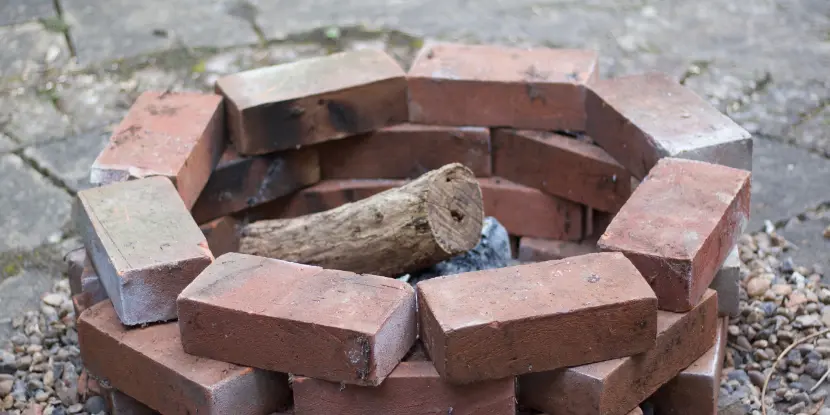
A crude brick fire pit. We expect you’ll do better than this.
Step-by-Step Instructions to Build a Fire Pit
1. Choose the Perfect Location
- Your fire pit should be at least 10 feet from your house or any flammable structures like fences or low-hanging branches.
- Level the area and comply with any local regulations or permits required for fire pits.
Pro Tip: Avoid windy spots to prevent smoke from constantly blowing toward your seating area.
2. Mark the Fire Pit Area
- Determine the size of your fire pit. A standard size is 36–44 inches in diameter.
- Use a tape measure to mark the center point of your pit.
- Attach a string to a wood stake, tie the other end around a piece of chalk, and draw a perfect circle on the ground.
- This circle represents the outer diameter of your fire pit.
3. Dig & Level the Base
- Dig out the marked circle to a depth of about 6–8 inches.
- Spread landscaping fabric on the cleared base to prevent weeds from growing through later.
- Add gravel or crushed stone in an even layer, about 2 inches thick, to create a stable foundation.
- Use a level to ensure the gravel layer is even throughout.
A solid base is critical for keeping your fire pit sturdy and secure.
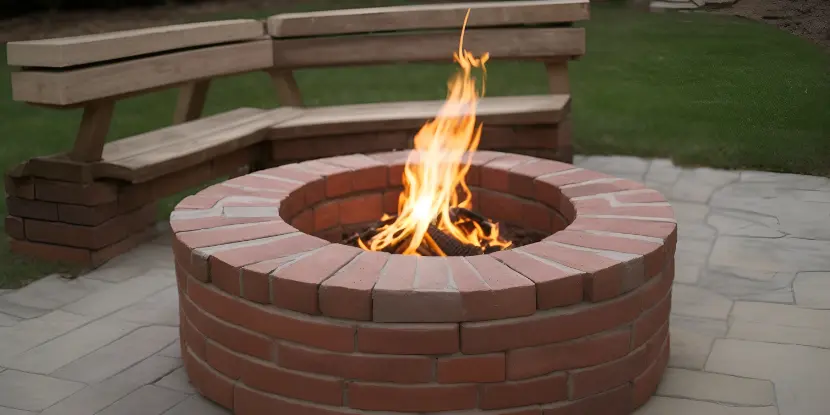
A double-walled brick fire pit surrounded by paving stone.
4. Lay the First Layer of Bricks
- Arrange the fire bricks in a circle directly on top of the leveled gravel. This will form the interior wall of the fire pit.
- Gently tap each brick into place, ensuring they sit firmly and evenly.
- Check regularly with a level to maintain uniformity.
Pro Tip: If you’re using a metal fire ring, place it inside the first layer of bricks now to guide the shape.
5. Build the Fire Pit Walls
- Mix your fire-resistant mortar as instructed on the packaging.
- Apply a generous layer of mortar to the top edges of your first row, spreading it with a trowel.
- For added stability, stagger the second layer of bricks over the first layer (this means the joints shouldn’t line up).
- Repeat this process, building layer by layer until the fire pit walls reach your desired height — typically 12–18 inches.
If you add an outer decorative wall with regular bricks or stones, follow the same process for a second layer.
6. Finish the Fire Pit Interior
- Allow the mortar to dry (usually 24–48 hours, depending on the product).
- Fill the bottom of the pit with an additional layer of gravel or crushed stone for improved drainage.
7. Add the Final Touches
- Surround your fire pit with outdoor seating to create the ultimate relaxation zone.
- Consider placing larger flat stones or pavers around the fire pit to protect grass or decking from excess heat.
- Add some outdoor pillows or string lights to enhance the vibe!
Now, all that’s left to do is grab your favorite snacks, light the fire, and enjoy!
Tips to Keep Your Fire Pit Safe
- Use dry wood to avoid excess smoke and sparking.
- Never leave the fire unattended.
- Keep a fire extinguisher or garden hose nearby to quickly handle any emergencies.
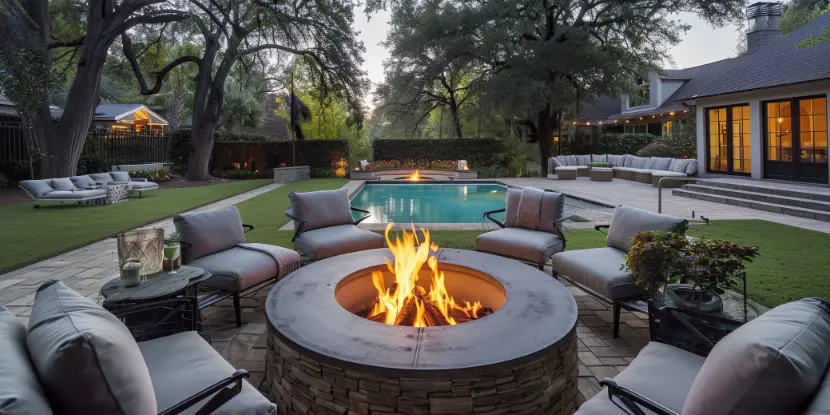
A fire pit finished with natural stone.
FAQs: Building a Fire Pit
Q: Can I use regular bricks instead of fire bricks?
Fire bricks are designed to withstand extremely high temperatures without cracking or crumbling, making them a safer option for a fire pit. Regular bricks may not be able to tolerate the heat and could potentially explode.
Q: How deep should the gravel layer be?
Aim for at least 2 inches of gravel for proper drainage, but you can add more. Just make sure it’s evenly distributed and level.
Q: Do I need a permit to build a fire pit in my backyard?
Regulations and permits vary by location, so check with local authorities before starting your project. Ignoring the rules could result in hefty fines or a demand to remove your fire pit.
Q: What wood is best for burning in a fire pit?
Hardwoods like oak, maple, or hickory are ideal for a fire pit because they burn longer and produce less smoke than softwoods like pine. Avoid using pressure-treated or painted wood, which can release toxic chemicals when burned.
Q: Can I use my fire pit during a burn ban?
Burn bans typically apply to open fires, which may include fire pits. However, some areas allow the use of covered or contained fire pits with appropriate safety measures. Check local laws and regulations before using your fire pit during a burn ban.
Q: How do I clean and maintain my fire pit?
To maintain your fire pit:
- Remove ashes regularly once fully cooled and check for any cracks or damage to the bricks or mortar.
- If your fire pit includes a metal ring, inspect it for rust and apply heat-resistant paint if necessary.
- Keep your fire pit covered to protect it from the weather when not in use.
Q: Can I cook food over a fire pit?
Yes, but use a cooking grate or skewer designed for outdoor fire cooking. Avoid using treated wood as fuel. Popular fire pit foods include marshmallows, hot dogs, and foil-wrapped vegetables or meats.
Q: Is using a fire pit on a wooden deck safe?
We don’t recommend it due to the high heat damage or fire risk. However, if you must, use a fire pit explicitly designed for decks and place a heat-resistant fireproof mat underneath. Follow all safety guidelines and keep the fire small and controlled.

